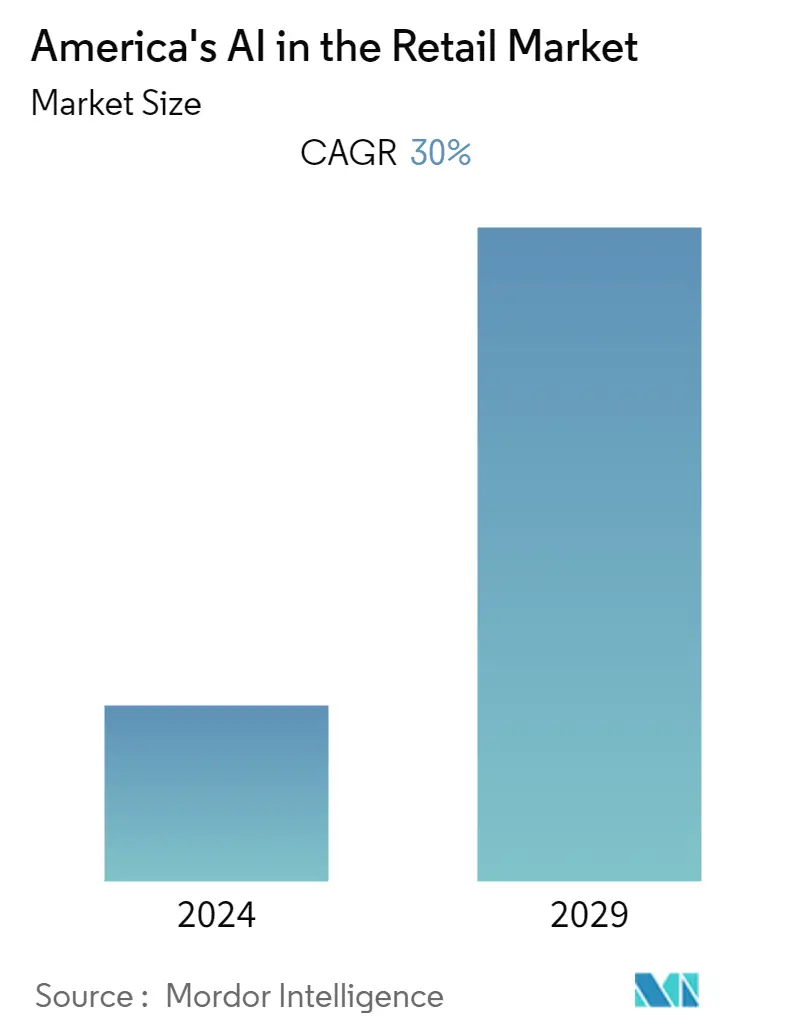Market Size of America's AI in the Retail Industry

| Study Period | 2019 - 2029 |
| Base Year For Estimation | 2023 |
| Forecast Data Period | 2024 - 2029 |
| Historical Data Period | 2019 - 2022 |
| CAGR | 30.00 % |
| Market Concentration | High |
Major Players
*Disclaimer: Major Players sorted in no particular order |
Need a report that reflects how COVID-19 has impacted this market and its growth?
America's AI in the Retail Market Analysis
America's AI in the retail market is expected to register a CAGR of 30% during the forecast period, 2021 - 2026. Artificial intelligence (AI) is driving faster business decisions in marketing, e-commerce, product management, and other areas of the business by decreasing the gap from insights to action. According to the United States Department of Commerce, retail sales in the United States are expected to reach USD 5.99 trillion in 2023.
- North America is expected to dominate the market with the largest market share, mainly because of the presence of several developed economies, such as the United States and Canada, focusing on enhancing the existing solutions in the retail space. North America hosts the primary AI solution providers and is an early adopter of AI technology.
- Machine learning and deep learning technologies are expected to have the most significant market shares, during the forecast period. Organizations in the retail industry are using machine learning and deep learning technology to offer a more personalized experience to the end-users, as well as to provide an interactive environment to them. According to a study by IBM, the adoption of AI in the retail and consumer products industries is projected to leap from 40% of companies today to more than 80% in three years.
- The use of artificial intelligence in retail spans across every aspect of the industry. Whether the goal is to optimize the supply chain, use existing data to increase conversion, or customize shopping experiences with predictive modelling and micro-targeting or pricing, AI can help meet these challenges in the retail space.
- The retailers in the United States are adopting AI for security and efficiency in the store. The security breaches in stealing the consumer data are growing in the region, thus pushing the companies to use AI as the solutions. For instance, in 2019, Adidas confirmed unauthorized third party access to customer data on the United States website.
- According to SOTI, online retail sales in the United States is projected to surpass USD 740 billion in 2023 as people in the region are more comfortable using an alternative delivery option of goods. Thus, AI plays a crucial role in shaping online retail sales in the country by streamlining the processes.
- Latin America is slowly adopting the AI in retail due to different countries having different taxation systems, even between countries in the same regionAmerica's AI in the retail market is expected to register a CAGR of 30% during the forecast period, 2020-2025. Artificial intelligence (AI) is driving faster business decisions in marketing, e-commerce, product management, and other areas of the business by decreasing the gap from insights to action. According to the United States Department of Commerce, retail sales in the United States are expected to reach USD 5.99 trillion in 2023.
- North America is expected to dominate the market with the largest market share, mainly because of the presence of several developed economies, such as the United States and Canada, focusing on enhancing the existing solutions in the retail space. North America hosts the primary AI solution providers and is an early adopter of AI technology.
- Machine learning and deep learning technologies are expected to have the most significant market shares during the forecast period. Organizations in the retail industry are using machine learning and deep learning technology to offer a more personalized experience to the end-users, as well as to provide an interactive environment to them. According to a study by IBM, the adoption of AI in the retail and consumer products industries is projected to leap from 40% of companies today to more than 80% in three years.
- The use of artificial intelligence in the retail sector spans across every aspect of the industry. Whether the goal is to optimize the supply chain, use existing data to increase conversion, or customize shopping experiences with predictive modeling and micro-targeting or pricing, AI can help meet these challenges in the retail space.
- The retailers in the United States are adopting AI for security and efficiency in the store. The security breaches in stealing the consumer data are growing in the region, thus pushing the companies to use AI as the solutions. For instance, in 2019, Adidas confirmed unauthorized third party access to customer data on the United States website.
- According to SOTI, online retail sales in the United States is projected to surpass USD 740 billion in 2023 as people in the region are more comfortable using an alternative delivery option of goods. Thus, AI plays a crucial role in shaping online retail sales in the country by streamlining the processes.
- Latin America is slowly adopting AI in retail due to varying taxation systems, even between countries belonging to the same region that is often fraught with duties. Additionally, the slow adoption of smartphones is posing a hurdle for companies to penetrate with AI in the retail ecosystem. According to GSMA, the mobile penetration rate in Latin America was only 67%, in 2018.
- With the recent outburst of COVID-19, the retail industry is facing significant supply chain disruption in the region and other problems. However, the usage of AI can help deliver goods to the customer by making a centralized AI unit that stores all the data about demand generation. It can also use a drone that uses the AI algorithm to deliver the most vital and essential supplies, such as medicine and protective gear, among others, to the consumer. are often fraught with duties, and slow adoption of smartphones are making difficulties for companies to penetrate with AI in the retail ecosystem. According to GSMA, the mobile penetration rate in Latin America was only 67% in 2018.
- With recent outburst of COVID-19, the retail industry is facing significant supply chain disruption in the region and other problems. But using the technology of AI, it can deliver the goods to the customer, by making a centralized AI unit that stores all the data pertaining to demand generation and can use a drone that uses AI algorithm to deliver the most vital and essential supplies such as medicine and protective gears and others to the consumer.
